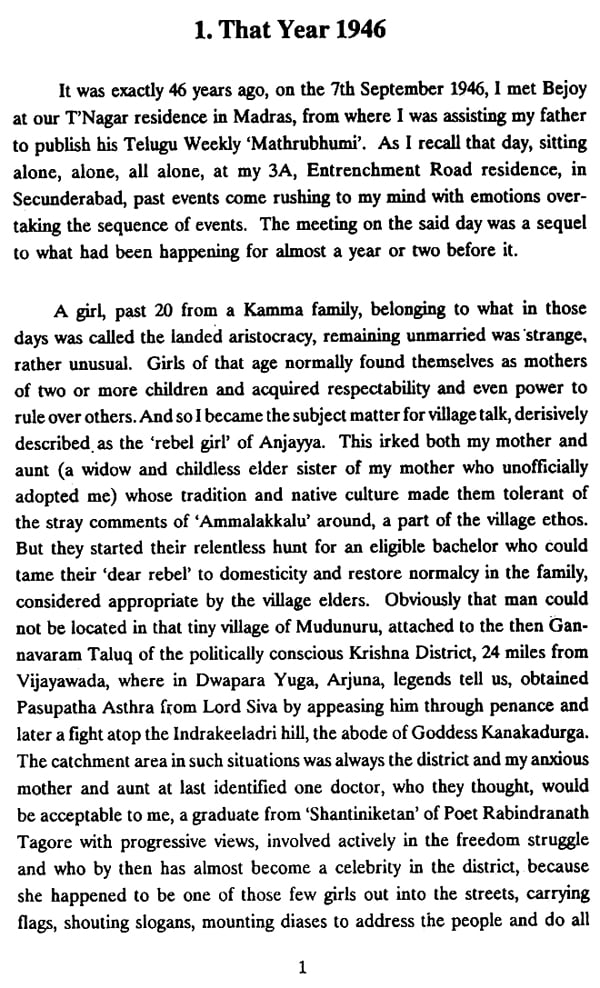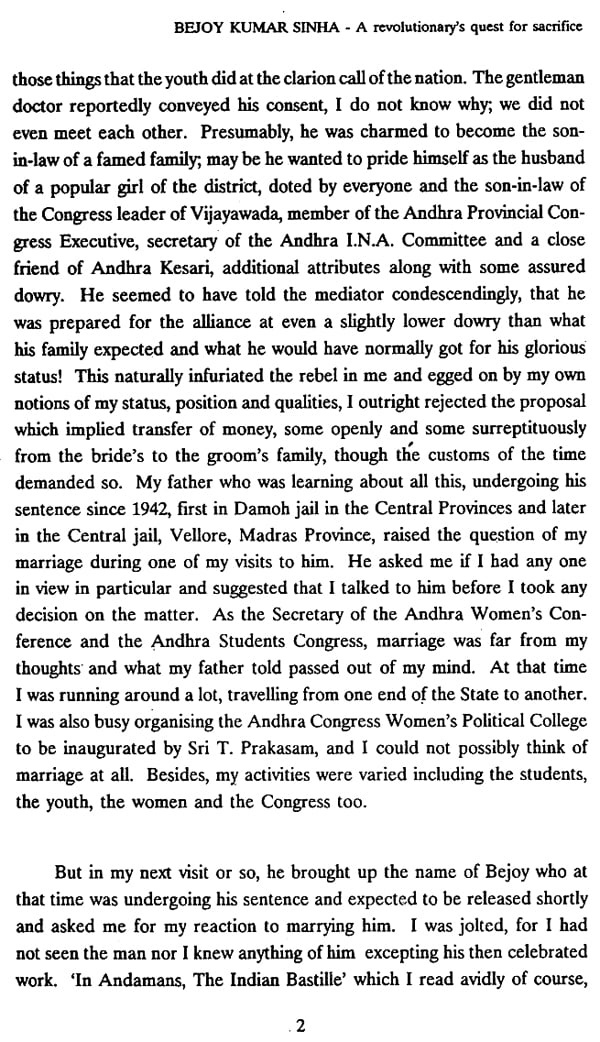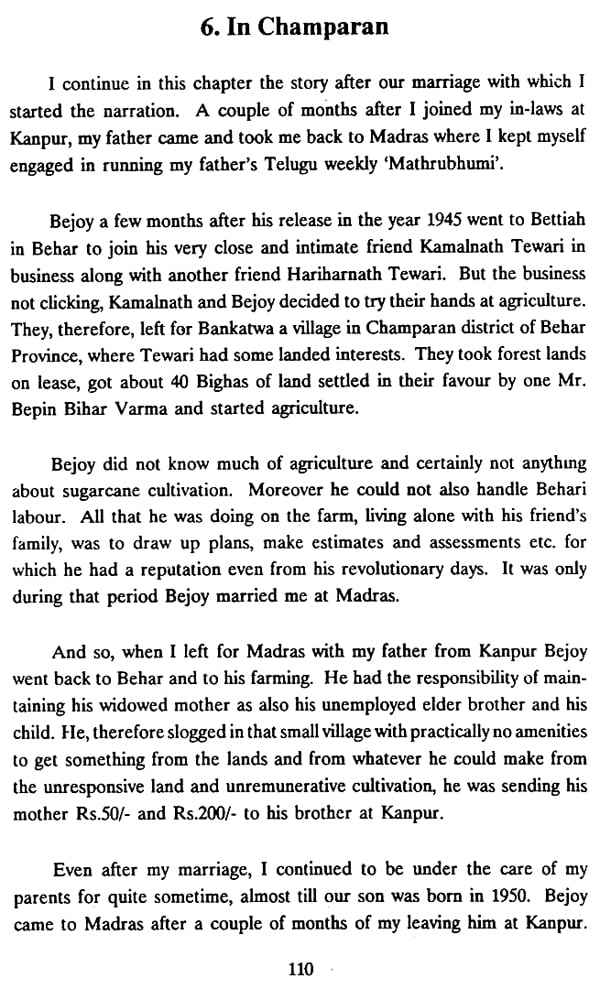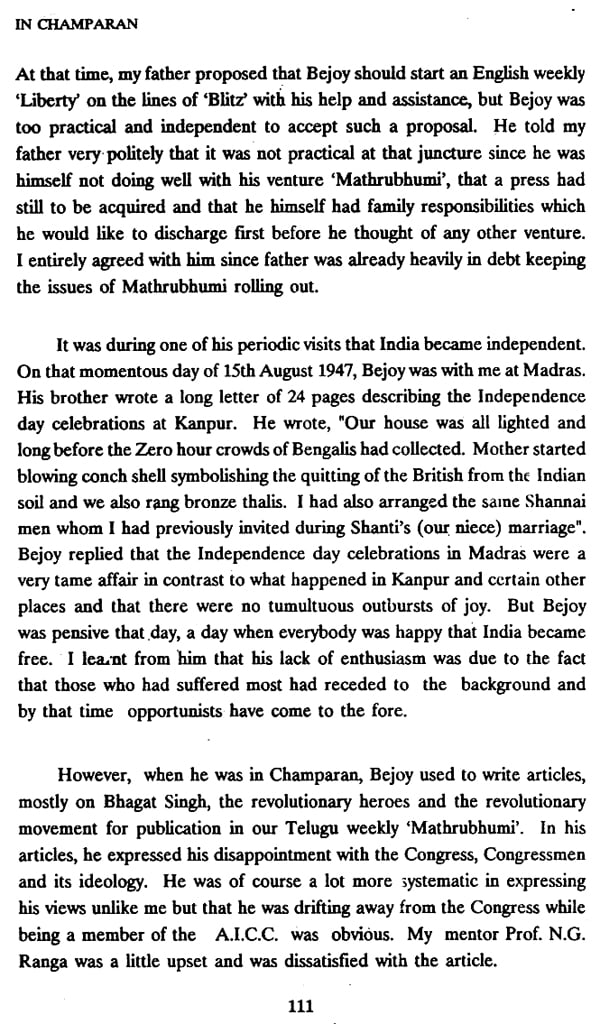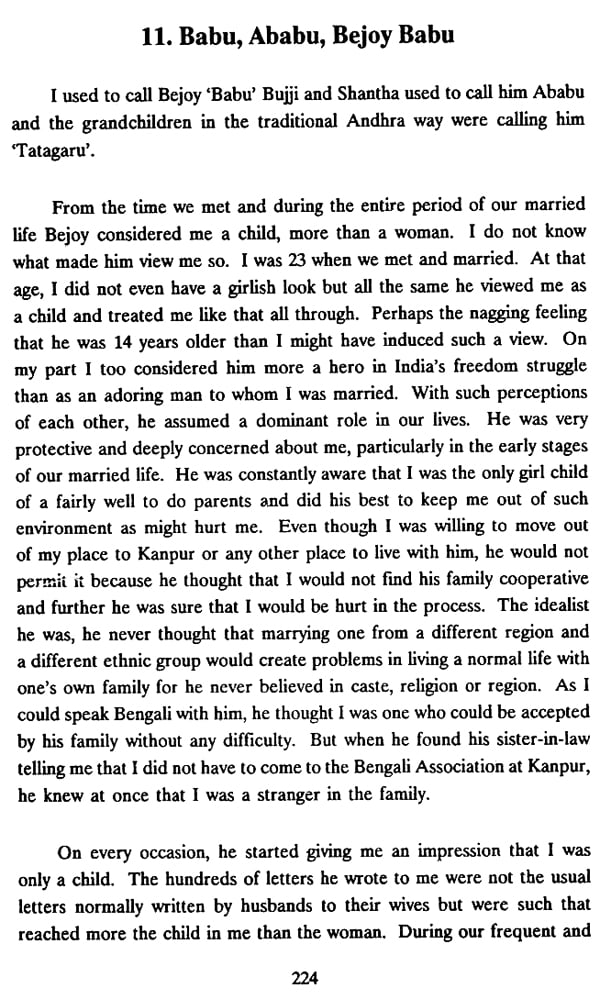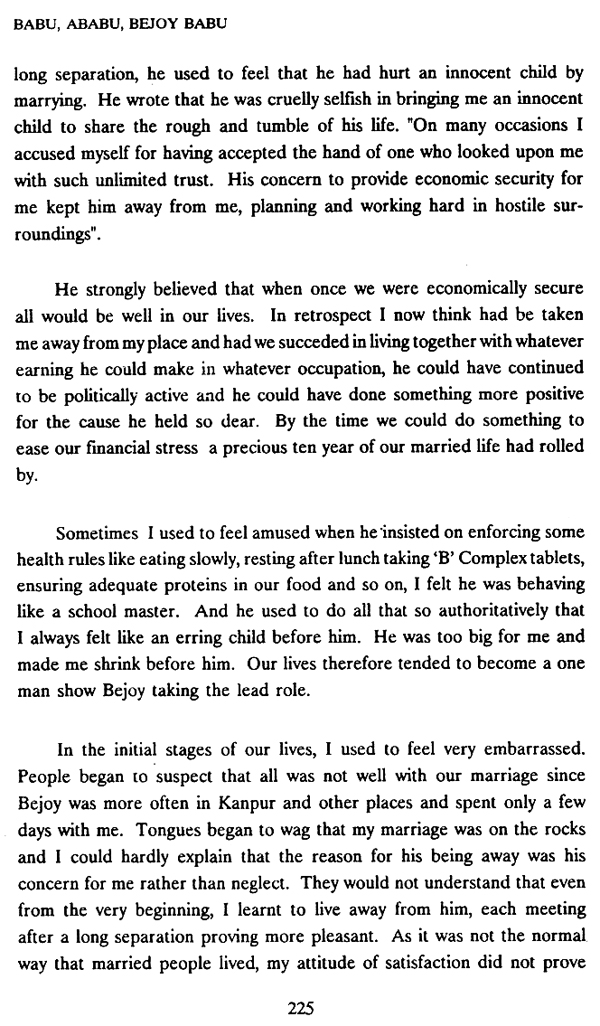
Bejoy Kumar Sinha- A Revolutionary's Quest for Sacrifice (An Old and Rare Book)
Book Specification
| Item Code: | NAY174 |
| Author: | Srirajyam Sinha |
| Publisher: | Bharatiya Vidya Bhavan |
| Language: | English |
| Edition: | 1993 |
| Pages: | 300 |
| Cover: | PAPERBACK |
| Other Details | 8.50 X 5.50 inch |
| Weight | 330 gm |
Book Description
During the days of India's epic struggle for freedom countless patriotic men and women gave up their occupations and displayed remarkable courage. Their acts of defiance and bravery are reminiscent of the instances of fight against injustice that are recorded in our ancient Epics and Puranas.
The struggle for national freedom from bondage took its inevitable toll of lives and many died unknown to fame and in total obscurity. Many who survived got disillusioned and disgusted with the shameless scramble for the loaves and fishes of office and the steady erosion of values in public life.
Bejoy Kumar Sinha was an young Bengali Youth of Kanpur who, at the age of 14, inspired by Paramahamsa Sri Ramakrishna, who epitomised the "dawn" of Modern Indian Renaissance, decided to lead a life of dedicated service and sacrifice - Seva and Tyaga and plunged into the battle for freedom. He was involved in the Lahore Conspiracy Case in which' his colleagues Bhagat Singh, Sukhdev and Rajguru, were sentenced to be hanged and he himself was externed and imprisoned in the Andamans. In those days of the crusade for freedom, incarceration in the Cellular Jail in the Andamans - Kala Pani - was viewed by the family members, as indeed the freedom-loving people of India in general, as despatch to Yama's abode itself.
Sri Sinha was set free in 1938 like many heroic legendary Freedom Fighters like Veer Vinayak Damodar Savarkar and other veterans, by the intervention of the first Congress Ministry under the Govt. of India Act, 1935 granting Provisional Autonomy. He was jailed again in 1941 and remained in prison till 1945.
When freedom dawned, Sinha took to journalism and writing, instead of seeking any office under Government. It is remarkable that Sinha, who did not believe in non-violence and who was fascinated by Marxism, es-chewed violence and started advocating open democratic processes.
The Bharatiya Vidya Bhavan believes that all sincere seekers after truth will eventually come to believe in the Majesty of the Moral Law and the Brotherhood of Man. The Bhavan is, therefore, happy to publish the biography of Bejoy Kumar Sinha, revolutionary, patriot, thinker and journalist. It is written by his Sahadharmacharini wife-Smt. Srirajyam Sinha, herself a freedom -fighter from the age of 19, and hailing from a gallant patriot family-that of Sri Anne Aanjaiah of Andhra Pradesh. Educated at Shantiniketan, Srirajyam married Sinha at the suggestion of her parents. She became the Director of Information and Public Relations of the Government of Andhra Pradesh.
Shri Mamidipudi Pattabhiram, Deputy Editor, "The Hindu" went through the manuscripts and made many valuable suggestions.
May this book inspire the youth of India to fight for noble causes, serve the country selflessly and fearlessly and uphold the cherished values of India's ageless cultural heritage!
It is enriching to go through the life story of a revolutionary hero who is ever rejuvenating himself through introspection without losing sight of the vision. Bejoy Kumar Sinha is the hero. A colleague and comrade of Bhagat Singh in Lahore Conspiracy Case, author of In Andaman -The Indian Bastille, Sinha is one of the unsung heroes of the Indian revolutionary movement. Other than himself, there could not be anybody better than his wife who could have done this job with sensitivity and truthfulness characteristic of him. She relives Sinha through this book. The volume gives an insight into the minds of the revolutionaries of that era.
What is the soul of the spirit that lies threaded in the beads of his life? Is that spirit relevant today? This biographic piece will, to some extent, answer, how and why the spirit of service and sacrifice is needed today even more than when we were fighting for political freedom. Social and moral independence are much more difficult and tortuous to fight for.
It is still a mystery with the author as to why Sinha instead of becoming a monk of the Ramakrishna Mission found himself in India's revolutionary movement and raises a question whether he would have served the country better from the religious front as against his chosen revolutionary front.
For Sinha the values of religiosity and revolution were complementary. It were the spiritual and moral values of religion, and not its dogmatic face, that inspired Sinha. It is these values which were the bedrock of the r evolutionary movement.
His philosophy of life was ‘Anasaktiyog', which was his source of strength and wanted his wife to read the book, and imbibe it. That attracted him to Geeta which teaches of detachment. He abhorred life of riches and wealth which he considered vulgar, lacking in finer cultural values. The thirst for personal happiness and worldly desires is like running after a mirage, he believed.
The Revolutionaries were not terrorists. They were humane and not entirely of the bomb-pistol cult. Sinha recollects in his notes:
"Bhagat Singh asked Mr. Justice Forde, if a man constructs a bomb in such a manner that it could not seriously injure any one and takes the utmost precaution that its explosion could not cause any injury, would he be guilty of attempted murder. We know the limited capacity of the bomb and took all possible precaution to prevent injury to anyone". "We did not intend to kill any one. Let the word malice be taken out and I am satisfied. We have a certain ideal, we employed certain means to achieve an ideal".
Sinha is very particular to emphasize many a time that they had no malice against any one. That was the the ethos of a spiritual revolutionary, not a terrorist.
When I met the Sikh militants in the Golden Temple in 1986, they mentioned that they were doing the same thing as Bhagat Singh did. How wrong they were, I told them. The perceptions of revolutionaries in the freedom struggle and the present-thy gun-wielding terrorists or extremists are quite different. That is why Sinha told his son that violence and terrorism did not and will not pay. He pointed out the essential difference between the violent ways of the revolutionaries in his days and terrorist activities of the Marxists for social change. It should not be termed as revisionist, according to him. The pamphlet thrown in by Bhagat Singh in the Central Assembly along with the bomb, quoted the French anarchist martyr valliant:
"It takes a loud noise to make the deaf hear".
At that time it was the silence of the grave pervading in the country. The wrong assumptions about the use of violence and violent means now have led to a situation where the noise of the bomb and the gun is so frequent and loud that people are becoming deaf.
This transformation and realisation had come to the revolutionaries during their period in the; .Ail in Andaman’s- after a great deal of study, discussion and introspect... is clear from their message to Mahatma Gandhi:
'Those of us who ever believed in terrorism... are convinced of its futility as a weapon it definitely retards rather than advances the cause of the country".
His vision of a new society after revolution is so pregnant with meaning. A glimpse of it is available from the type of queries he had raised for himself while writing his book on his visit to the Soviet Union. He went there in search of a New Man in the society, after the revolution. For him socialism is not mere material progress. He considered emphasis on supply of only material things crude and debasing for human progress and wanted to build a new society based on democratic mode consistent with higher values of man, of freedom, tolerance and all-embracing sympathy. His queries were basic: Have the youth the crusading zeal of earlier revolutions? Is the citizen becoming increasingly happy and free? (Avoidance of the expression 'pleasure' by him is noteworthy). What are the conceptions that he is developing for family life, sex, love, beauty, religion and incentives for labour? Is his nationalism balanced with his loyalty to internationalism? Have the women lost their feminine charm and innate qualities as a sequel to full equality with man? Have family ties become weakened? How far has the new order of society been able to make life richer and fuller in material and spiritual sphere?
In his underground life in the Nepal village, it was revolting for him to find a Brahmin girl smoking and puffing, a symbol of lack of culture, and psychological slavery. He shed tears on it.
When as a student he was carrying on distributorship, to supplement his income, he felt a sense of compunction and wrote in his diary whenever he had to tell lies about the qualities of the products he was canvassing for.
The above simple but most fundamental questions and Sinha's commitment to truth, and his attitude towards mental slavery of addiction, of smoking, or alcohol by women or otherwise are in the direction of his vision of a new le Nty and the test of its enrichment after its actual establishment. These are vant as goals of all societies. The present situation is that both the dominant ideologies have failed, for the present. Both the systems are producing "poverty of culture amidst plenty of material goods and services" with human and family alienation increasing with every additional stage of development and economic progress.
As terrorism grows all over the world, the basic approach towards revolution will have to change. Terrorism is not revolution nor it can usher in revolution. It can bring chaos and unmanageable tension.
So, in the new era, the issue of relationship between means and ends will be of great significance for revolutionaries all over the world. There cannot be a fully violent or fully non-violent society. The struggle between Good and Bad, Noble and Evil, Violence and Non-violence is eternal. No perfect society is ever formed. Sometime one is dominant, sometime the other, depending on the level of consciousness of the people. Revolution is a struggle towards perfection of man and society. Each society is a reflection of the levels of consciousness that it has reached through its own experience. Srirajyam has mentioned at many points that Sinha was a perfectionist. Perfectionism in life, society and polity means being ever vigilant about the integration of ends and means.
In all democracies political, social and economic, leaders talk of peace and ending of violence and terrorism. Without that there can be no peaceful existence anywhere. But while criticising violence and terrorism they fail to introspect much they are themselves responsible for it. It may be relevant to rem about the message of the great patriot Madam Bhikubai Rustamji CMt who for the first time unfurled the national flag at the International Socialist Conference in 1909 in Germany. She gave the message to the people of India in Support of Bhagat Singh, in defence of use of violence in his revolutionary activities.
"Some of you say as a woman I should object to violence. Well, Sirs, I had that feeling at one time. Three years ago it was repugnant to me even to talk of violence as a subject of discussion. But owing to the heartlessness, the hypocrisy and rascality of the liberals, that feeling is gone".
**Sample Pages**

